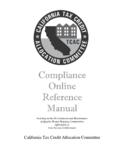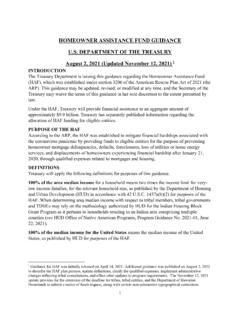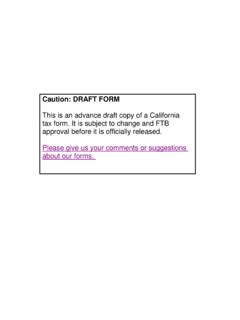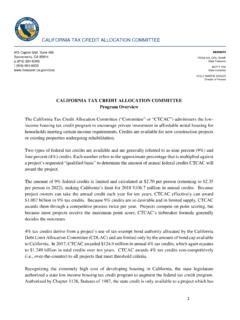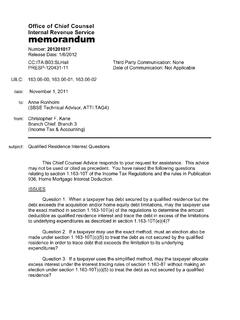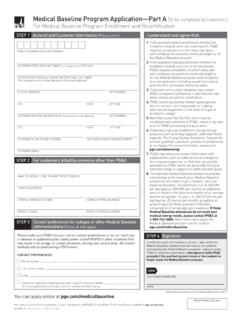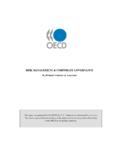Transcription of LB&I Concept Unit - IRS tax forms
1 LB&I Concept UnitUnit NameDetermining Liability AllocationsPrimary UIL of Certain LiabilitiesLibrary LevelTitleKnowledge BasePartnerships ShelfGeneral ConceptsBookPartnership LiabilitiesChapterLiability AllocationsDocument Control Number (DCN)PAR-C-004 Date of Last Update09/15/20 Note: This document is not an official pronouncement of law, and cannot be used, cited or relied upon as such. Further, this document may not contain a comprehensive discussion of all pertinent issues or law or the IRS's interpretation of current of ContentsGeneral OverviewDetailed Explanation of the ConceptExamples of the ConceptIndex of Referenced ResourcesTraining and Additional ResourcesGlossary of Terms and AcronymsIndex of Related Practice UnitsDRAFT3 General OverviewDetermining Liability AllocationsThe Concept of liability allocation is covered under IRC 752 and the related liability allocations have a major impact on the computation of a partner s basis in his partnership interest
2 (outside basis). A partner must calculate outside basis in many situations, including when he receives a routine distribution of money, when he is allocated a loss, when the partnership redeems his interest in a liquidating distribution, or when he sells his interest in the partnership reports each partner s share of partnership liabilities at the end of the year on Schedule K-1 Part II, Section K. Liabilities are reported on Schedule K-1 in three categories: recourse, nonrecourse, and qualified nonrecourse. Qualified nonrecourse financing is nonrecourse financing borrowed for use in an activity of holding real property and is primarily relevant for purposes of the at-risk rules (which are beyond the scope of this practice unit).
3 The subchapter K rules for allocating liabilities to partners distinguish only between nonrecourse and recourse debts. An increase in a partner s share of partnership liabilities is treated as a contribution of money by the partner to the partnership and thus increases his outside basis. A decrease in a partner s share of partnership liabilities is treated as a distribution of money to the partner and thus decreases his outside basis. IRC 752(a) and (b).Back to Table of ContentsDRAFT4 General Overview (cont d)Determining Liability AllocationsNot all liabilities shown on a partnership s tax return balance sheet ( form 1065, Schedule L) are recognized as liabilities for tax Reg.
4 Defines partnership liabilities. In general, for a liability to be recognized for tax purposes, it must (1) create or increase the basis of any of the partnership s assets, (2) give rise to a tax deduction, or (3) give rise to an expense not properly deductible or chargeable to capital. With some liabilities such as environmental obligations, tort obligations, contract obligations, and pension obligations, the obligation might be recognized for Generally Accepted Accounting Principles (GAAP) purposes but do not meet the tests set forth in Treas. Reg. and do not affect basis for tax purposes until satisfied.
5 For additional information, see the Practice Unit on Recourse vs. Nonrecourse Liabilities. Back to Table of ContentsDRAFT5 Detailed Explanation of the ConceptDetermining Liability AllocationsRecourse and Nonrecourse Liability AllocationsAnalysisResourcesAllocating Recourse LiabilitiesPublication 541 and Treas. Reg discuss the allocation rules for recourse liabilities. A partnership liability is a recourse liability to the extent that any partner or a related person has an economic risk of loss for that liability. A partner's share of a recourse liability equals his economic risk of loss for that liability.
6 A partner has an economic risk of loss if that partner or a related person would be obligated, whether by agreement or law, to make a payment to the creditor or a contribution to the partnership with respect to the liability if the partnership were constructively liquidated. A partner who is the creditor for a liability that would otherwise be a nonrecourse liability of the partnership has an economic risk of loss in that sum, a partner bears the economic risk of loss if the partner or related person (1) has a payment obligation, Treas. Reg (b) (except for (d)(2)); (2) is a lender to the partnership, (c) (except for (d)(1)); (3) guarantees payment of interest, (e); or (4) pledges property as security for a partnership liability, (h).
7 Treas. Reg. Pub. 541 Back to Table of ContentsDRAFT6 Detailed Explanation of the Concept (cont d)Determining Liability AllocationsAnalysisResourcesAllocating Recourse Liabilities (cont d)A partner has an economic risk of loss if that partner or a related person would be obligated, whether by agreement or law, to make a payment to the creditor or a contribution to the partnership with respect to the liability if the partnership were constructively liquidated. This constructive liquidation test is a mechanical test used to quantify the extent of each partner economic risk. The constructive liquidation test has the following steps that are deemed to occur at the same partnership liabilities are due and payable in for property contributed to secure a partnership liability, the assets held by the partnership are assumed to be worthless (including cash).
8 Assets are sold in a taxable exchange for zero sales resulting losses and other attributes are allocated to the partners based on the partnership partnership result of this hypothetical liquidation will normally produce deficits in the capital accounts of one or more partners. The extent to which a partner would be required to contribute capital to eliminate these deficits represents the extent to which the partner is economically at risk on the recourse debt. Treas. Reg. Treas. Reg. (b) Treas. Reg. (b)(4) Treas. Reg. (d)(2)Back to Table of ContentsDRAFT7 Detailed Explanation of the Concept (cont d)Determining Liability AllocationsAnalysisResourcesAllocating Recourse Liabilities (cont d)In limited liability companies (LLCs), LLC members are usually not economically at risk on LLC debt, absent a deficit-restoration obligation or member-level guarantee.
9 If, however, an LLC member is economically at risk on an LLC liability, the constructive liquidation test will indicate the extent to which the LLC liability is allocated to that member under the recourse liability partner s nonrecourse loan to a partnership is a recourse loan to the partner to the extent another partner does not bear the economic risk of loss. Allocating Nonrecourse Liability With a Greater Than 25% Interest Guaranteed by a PartnerIf partner or related person guarantees the payment of more than 25% of the total interest that will accrue on the partnership nonrecourse liability, and the guarantor will be required to pay substantially all ofthe guaranteed future interest if the partnership fails to do so, then the liability is treated as two separate partnership liabilities.
10 The partner or related person is treated as bearing the economic risk of loss for the liability to the extent of the present value of the guaranteed future interest. The remainder of the stated principal amount of the liability constitutes a nonrecourse liability. This rule does not apply for guarantees that do not exceed the lesser of five years or one-third of the term of the liability. Under a de minimis exception, this rule also does not apply if a partner or related person is a 10 percent or less partner any year when a partner and guarantees the interest on a partnership loan that is qualified nonrecourse financing.










